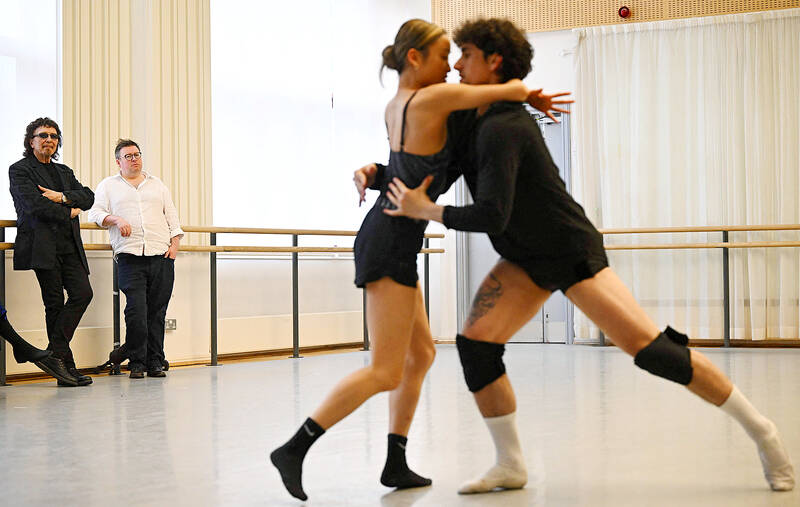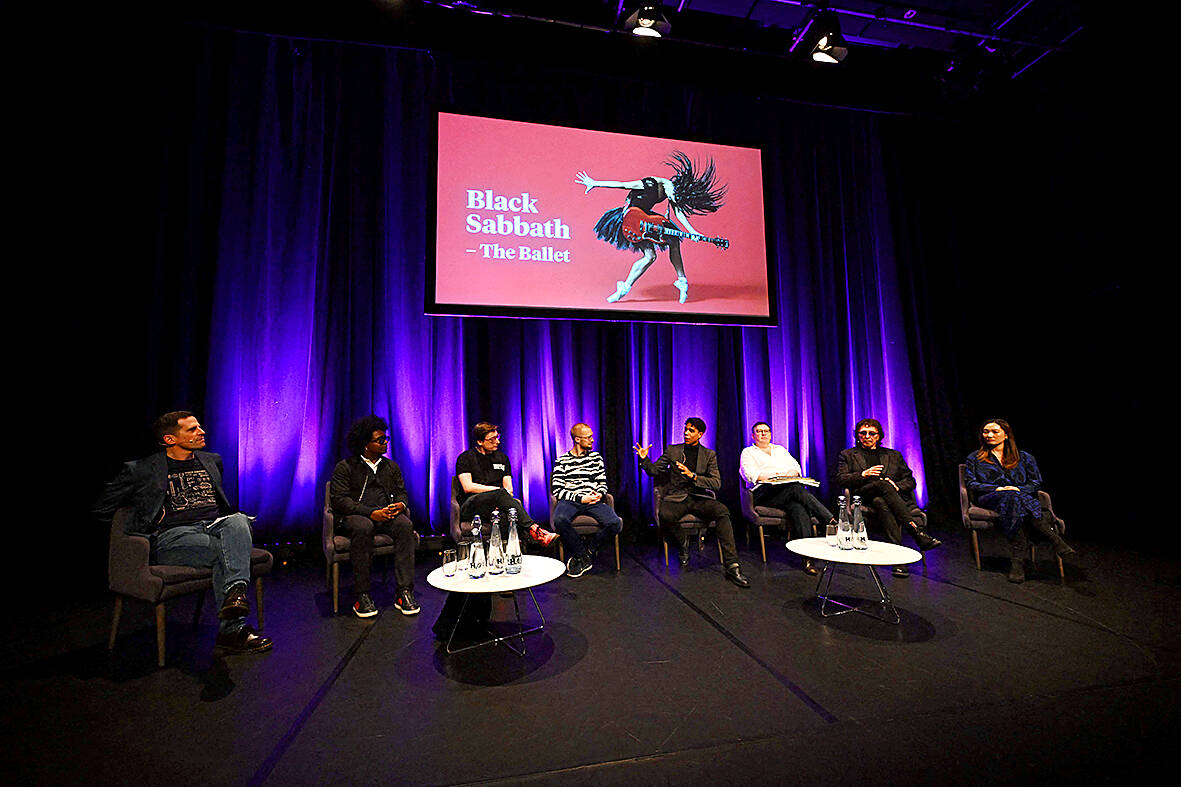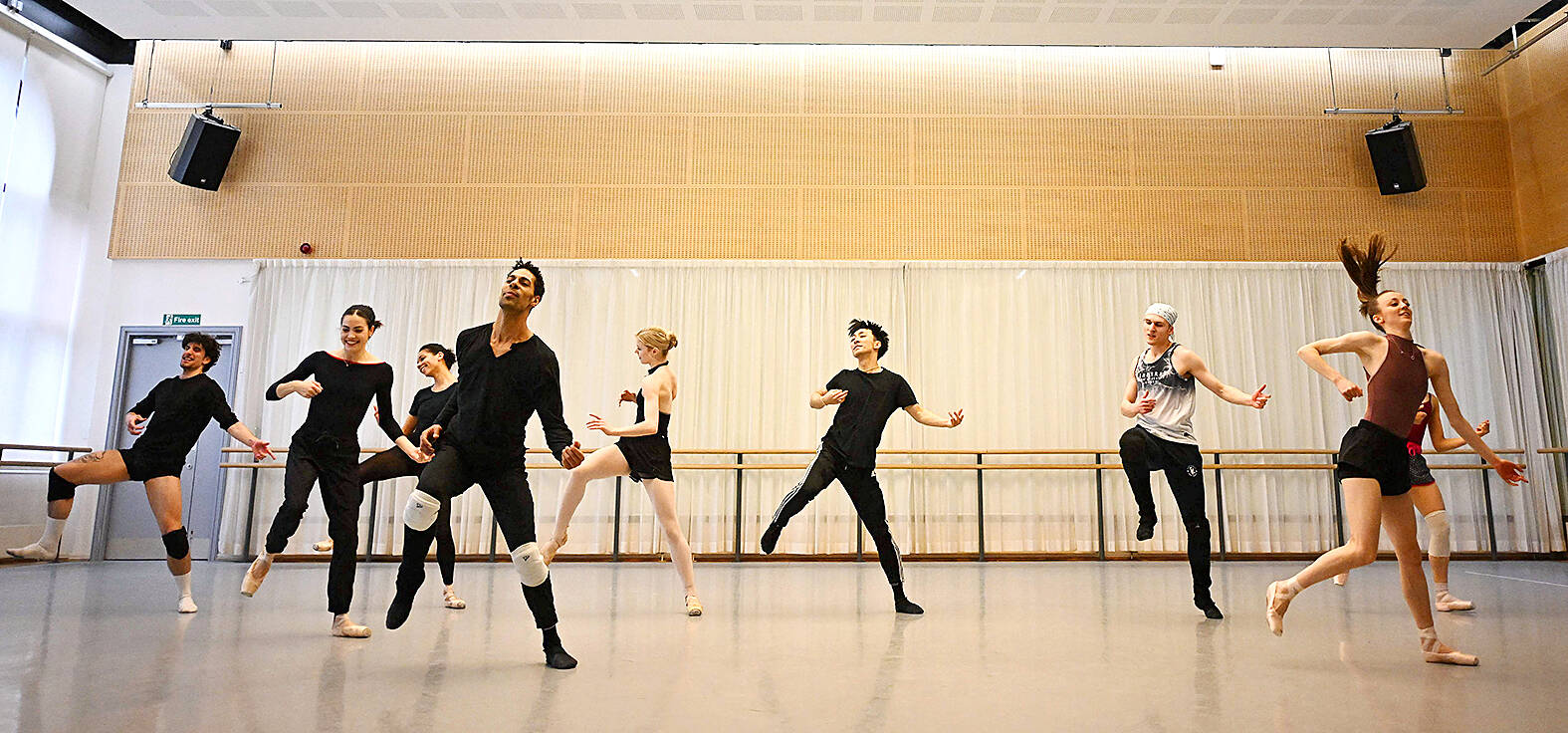In a rehearsal studio in central England, dancers are getting to grips with new, heavy metal-inspired ballet steps. Moving gracefully in unison, they team pirouettes with air guitar, leaps with head banging.
Welcome to Black Sabbath — The Ballet, the brainchild of Cuban dance star Carlos Acosta, artistic director of the Birmingham Royal Ballet.
Determined to celebrate the cultural treasures of the UK’s second city since his arrival in 2020, Acosta took his idea to Black Sabbath co-founder and guitarist Tony Iommi, who gave it his blessing along with the group’s original vocalist Ozzy Osbourne.

Photo: AFP
“I was fascinated with the idea. I thought, ‘How are they going to do that?’” Iommi, 75, said Thursday in Birmingham.
“I just couldn’t imagine how they’d do ballet to Black Sabbath and then I thought, well, maybe they’re going to use the ... softer tracks. But no, they went for Black Sabbath, War Pigs, Iron Man,” he said. “I think I was just really intrigued.”
The full-length, three-act ballet opens in Birmingham, the pioneering group’s home city, in September before going on tour. Rehearsals have just begun.

Photo: AFP
NOT A DOCUMENTARY
According to writer Richard Thomas, the ballet is the “rags-to-riches story” of four young men who went from the “factory floor to one of the most successful bands in rock history,” although he stressed it would not be a documentary set to music and dance.
The legendary group’s original line-up was Osbourne, Iommi, bassist Geezer Butler and drummer Bill Ward.

Photos: AFP
They were instrumental in creating heavy metal in the early 1970s with dark and high-volume guitars coupled with a keen interest in the occult.
“It’s very simple. It’s like Black Sabbath meets the Birmingham Royal Ballet,” Thomas said.
There would, however, be use of archive interviews and also some famous Black Sabbath stories such as how Iommi lost the tips of two fingers in an industrial accident on his last day working at a sheet metal factory.
Also making an appearance will be the tale of the “Stonehenge” set that had to be dumped after a measurements mix-up meant it was so big it wouldn’t fit into auditoriums.
And he said there might “possibly be a brief mention of the bat incident,” in which Osbourne thought a fan had thrown a rubber bat onstage only to discover — after he took a bite — that it was real.
For Acosta, 39, there had been an immediate rapport with Iommi after he first approached him with the project.
“I didn’t know the man (or) how we were going to hit it off, but obviously we both come from the same background in terms of working-class and poor families ... and the chemistry was instant,” he said.
GLORIOUS IRREGULARITY
The former star dancer said he came to the music of Black Sabbath late due to growing up in Cuba.
“I grew up in the 1980s, I wanted to be Michael Jackson. I didn’t know anything about Black Sabbath,” he said, adding that he only discovered the group through a friend in the late 1990s.
“This was the music of those who are marginalized so I found it very interesting,” he adds.
Musically, composer Chris Austin said it had been difficult to know where to start as the Black Sabbath back catalogue was so huge.
But he said once they narrowed it down it had been easy to be inspired by the music’s “glorious irregularity” and “enormous shifts of tempo,” combined with Osbourne’s early “stratospheric” vocals.
The show will be a treat for fans after the group, including three of the original members, ended their last-ever tour with a final concert in Birmingham in 2017.
Iommi said he was as interested as everyone else to discover how the ballet would turn out, but that he had been confident in Acosta and his team from the start.
“I know from our fans that there is a lot of excitement to come to the show,” he said, adding that he expected people would be particularly keen to join in.
“I think it will be great.”

In the March 9 edition of the Taipei Times a piece by Ninon Godefroy ran with the headine “The quiet, gentle rhythm of Taiwan.” It started with the line “Taiwan is a small, humble place. There is no Eiffel Tower, no pyramids — no singular attraction that draws the world’s attention.” I laughed out loud at that. This was out of no disrespect for the author or the piece, which made some interesting analogies and good points about how both Din Tai Fung’s and Taiwan Semiconductor Manufacturing Co’s (TSMC, 台積電) meticulous attention to detail and quality are not quite up to

April 21 to April 27 Hsieh Er’s (謝娥) political fortunes were rising fast after she got out of jail and joined the Chinese Nationalist Party (KMT) in December 1945. Not only did she hold key positions in various committees, she was elected the only woman on the Taipei City Council and headed to Nanjing in 1946 as the sole Taiwanese female representative to the National Constituent Assembly. With the support of first lady Soong May-ling (宋美齡), she started the Taipei Women’s Association and Taiwan Provincial Women’s Association, where she

Chinese Nationalist Party (KMT) Chairman Eric Chu (朱立倫) hatched a bold plan to charge forward and seize the initiative when he held a protest in front of the Taipei City Prosecutors’ Office. Though risky, because illegal, its success would help tackle at least six problems facing both himself and the KMT. What he did not see coming was Taipei Mayor Chiang Wan-an (將萬安) tripping him up out of the gate. In spite of Chu being the most consequential and successful KMT chairman since the early 2010s — arguably saving the party from financial ruin and restoring its electoral viability —

It is one of the more remarkable facts of Taiwan history that it was never occupied or claimed by any of the numerous kingdoms of southern China — Han or otherwise — that lay just across the water from it. None of their brilliant ministers ever discovered that Taiwan was a “core interest” of the state whose annexation was “inevitable.” As Paul Kua notes in an excellent monograph laying out how the Portuguese gave Taiwan the name “Formosa,” the first Europeans to express an interest in occupying Taiwan were the Spanish. Tonio Andrade in his seminal work, How Taiwan Became Chinese,